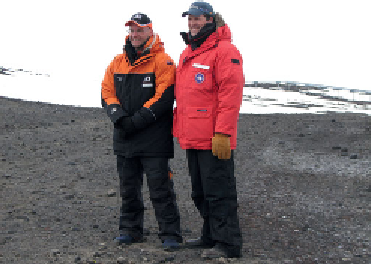Geoscience Reference
In-Depth Information
Figure 8.23
Erik Barnes (left) wearing New Zealand
Antarctic clothing and Brian Stone (right) with US
clothing. (Credit: Chris Demarest, NSF)
keeping the body warm than 100 years ago when
the
first explorers dressed in cotton and wool.
An often-used guideline is that you should never
dress or work so that you perspire
becoming wet
with sweat is a sure way to become chilled,
especially if the sweat freezes! When perspiration
occurs, the clothing needs to draw that moisture
away from the body. Most programmes provide several layers of lightweight clothing
instead of one or two layers of bulky, thick gear. Layers provide air for insulation
and can be added or removed depending on the temperature
-
-
they also allow the
wearer to move freely.
A typical clothing
that scientists and support personnel take to Antarctica
weighs about 20 kg and consists of a multi-layer system of polypropylene, down and
thinsulate. Footwear includes double insulated mountaineering boots for moderate
temperatures and conditions, and knee-high muk-luks for extremely cold weather.
Layers of highly insulated socks are worn and for those who need them, warmer
packs are provided which are placed between the skin and socks; when broken,
the packs provide extra warmth. Fingers are prone to frostbite and two or three
layers of gloves are worn. The heat packs can also be used inside gloves. The intense
sunlight and glare of the snow is hard on the eyes and sunglasses or ski goggles
are worn at all times outdoors.
As a safety precaution, the buddy system is used when venturing away from a
station, as is a sign-out procedure, which includes details of destination, time and
date of departure and expected time of return. Most bases require that every party
leaving the station carries a hand-held VHF radio. Being alone in the Antarctic is
dif
'
kit
'
cult!
When proper precautions are taken, Antarctica is a very safe place to work with a
very low mortality. Clothing, eye protection and sun block are used to protect
workers from the strong UV rays especially in spring. Though protection is the best
defence, frostbite and hypothermia are very real risks in Antarctica. Every day
bumps and bruises, sprained ankles and cut
fingers are just as likely to occur in
Antarctica as anywhere else, but if a person becomes seriously ill or injured, it is
often impossible to evacuate them. This is especially true when the weather goes
sour and for deep
field parties and those staying over the winter. Medical care in
Antarctica became front page news in 1999 when Jerri Nielsen, the only doctor
wintering over at the United States
'
South Pole Station, diagnosed and treated herself




Search WWH ::

Custom Search